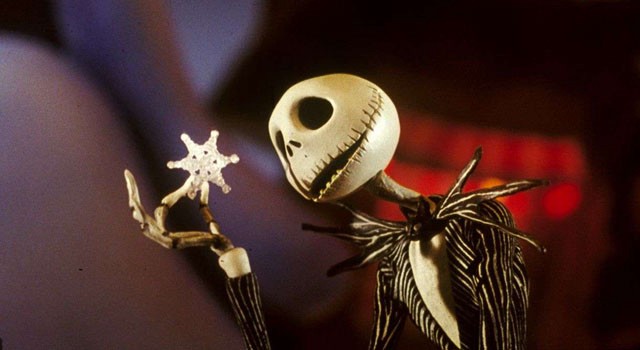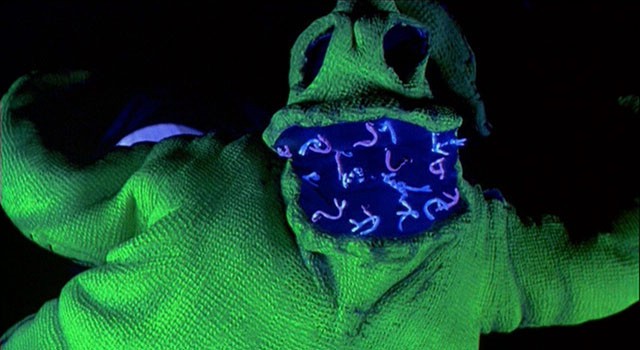
When it was released twenty years ago, The Nightmare Before Christmas was not an immediate success. However, over the following two decades, it has become one of the most beloved holiday movies, and composer Danny Elfman admits that autograph seekers inevitably have The Nightmare Before Christmas merchandise for him to sign above all other films he has worked on.
When the 15th Anniversary 2-Disc Collector’s Edition DVD was released in 2008, Elfman joined in with producer Tim Burton and director Henry Selick to record a commentary track. This track, along with many of the other bonus features, is also included on the 3D Blu-ray, which was released in 2011 (and likely all other annual releases as Disney moves forward).
Seeing as we’re at the half-way point between Halloween and Christmas, and since it is the 20th anniversary of the film’s release, it seemed appropriate to revisit the film and hear what the filmmakers had to say about the production.
The Nightmare Before Christmas (1993)
Commentators: Tim Burton (producer), Henry Selick (director), and Danny Elfman (composer)
1. The origin of the story dates back to when Burton worked at Disney as an animator for The Fox and the Hound and The Black Cauldron, which was around the time he was coming up with his short films Vincent and Frankenweenie. He was also inspired by the Rankin/Bass holiday specials aired on television. Burton eventually developed the idea into a poem, which can be found on the DVD and Blu-ray, read by Christopher Lee.
2. Because he grew up in Burbank, Burton never really experienced seasons, which is why he tends to identify them with decorations for holidays. The inevitable colliding of Halloween and Christmas decorations in stores and other businesses helped inspire him for the story. Additionally, as a child, he would sneak Halloween decorations into the Christmas tree ornaments, which also inspired him to juxtapose the two holidays in the film.
3. From the poem, Burton worked with Elfman to develop the songs. Rather than a traditional musical, which often features characters stopping the story to break out in song, they wanted the dialogue to flow into the songs, making it more like an opera. Stop-motion production actually began (with the “What’s This?” song in Christmas Town) before a script was completed.

4. Burton insisted that there would be no magic in Halloween Town.
5. The film was developed over the course of 20 years, during which Burton pitched it to TV stations as a stop-motion holiday special as well as book publishers. He always wanted to make it using stop-motion animation in honor of Ray Harryhausen and the Rankin/Bass specials.
6. Henry Selick turned down a job working with MTV on a series based on his short film Slow Bob and the Lower Dimensions in order to direct this film.
7. Elfman drew tongue-twisting inspiration for “What’s This?” from Gilbert & Sullivan’s “I Am the Very Model of a Modern Major-General” from “The Pirates of Penzance.”
8. Burton’s original drawings for Jack Skellington had him wearing a black suit. Selick changed this to a pinstripe pattern because in early screen tests, Jack’s body seemed to disappear in the dark background of Halloween Town.
9. At one point in production, Disney requested that Selick and Burton put eyeballs on Jack Skellington.
10. Elfman, who provides the singing voice of Jack, compares Jack’s struggles to his own coming to terms with being the “king” of Oingo Boingo but wanting to do something more, leading him to composing scores for films.
11. All of Jack’s songs start slow and in some form of emotional distress. He then has a change of heart and eventually becomes worked up into a frenzy and rallies himself by the end.
12. The scene in which Lock, Shock and Barrel remove their masks to reveal similar faces beneath was based on the season five episode of The Twilight Zone called “The Masks,” which had a huge impact on Burton as a child.
13. In the original cut of the film, after shoving Santa down to Oogie Boogie’s lair, Lock, Shock and Barrel set up chairs with popcorn to watch the mayhem. Burton killed the scene because he felt this crossed a line from being mischievous to something darker.
14. Selick requested that Elfman rework the song “Making Christmas” so the film could cut back and forth from Halloween Town to Christmas Town, in order to show a difference in tone of the music and imagery.
15. The Melting Man effect was achieved by using a hot-air blower on the puppet to melt his face a little bit before each take so it would droop a bit.
16. Vincent Price was originally set to play Santa Claus, but he had recently lost his wife and Selick felt he had too much sadness in his voice at the time. The part eventually went to San Francisco actor Edward Ivory, who delivered a more traditional Santa voice.
17. All of the characters have very small feet. This is because they are based on Burton’s drawings, and he always draws characters with freakishly small feet.
18. Oogie Boogie was conceptualized as an animated character from 1927. The puppet was extremely thick and covered in a lot of rubber, so the production had the strongest animators pose it.
19. Late Pixar animator Joe Ranft worked as a storyboard supervisor on the film, and he was known for always wanting more gory and grotesque imagery.
20. All the clouds in the flying sequences are hand-made from cotton.
21. The flying vampire left as a Christmas present was designed to slightly resemble Mickey Mouse. Even though this was a Disney film, the studio only approved it if it didn’t look too much like its mascot.
22. Because stop-motion animation was (and still is) a very limited field, Burton and Selick were able to have their pick of the best animators for the film. Aside from a new Gumby TV series, there was no other stop-motion animation film in competition during production.

23. Because Oogie Boogie was made of hundreds of individual bugs, any member of the crew who had down time was given the job of building bugs for his final unraveling scene.
Best in Commentary
- Burton: “I could never really draw Disney eyes. I think that’s why they kicked me out of the animation department. I couldn’t draw in that style very well.”
- Selick: “Starting up Nightmare, actually going into production. looking back on the whole experience, that was probably the craziest part of it, that we began a film when we didn’t actually have a script. We only had a few songs from Danny.”
- Selick: “Sally’s a very original character Tim dreamed up. We all wondered if it was his ideal woman: dead, beautiful, voluptuous, lots of stitches.”
Final Thoughts
Tim Burton is notorious for having slow and often dull commentaries. This presentation, which cuts around all three commentators (who appear to have recorded separately) leaves very little down time. The disadvantage is that you lose a certain degree of the here-and-now of the running commentary. Still, it helps balance out the information being dispensed and makes things flow much better than if Burton were flying solo.
While there’s not a lot of new and shocking information revealed in the commentary, this is an excellent way to look at the picture again. With fifteen years behind them, all three participants have a lot to say, and they give it a proper historical context.
Check out more commentary commentary in the Commentary Commentary archives
Related Topics: Commentary Commentary, Disney
